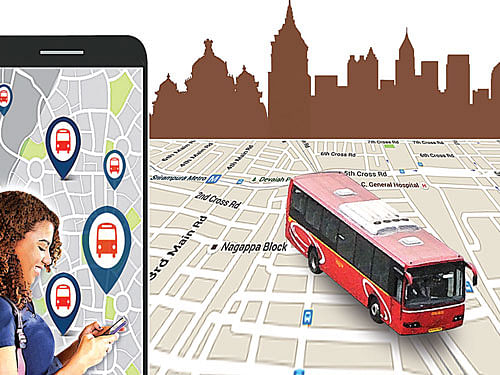
By marrying GPS-tracked buses with driver discipline, transparency with public connect, can the soon-to-be-launched Intelligent Transport System make BMTC bus attractive enough for Bengalureans to shed their cars?
Dominating every debate on the city’s public-private transport system, the Bangalore Metropolitan Transport Corporation (BMTC) defines our daily life on the road. As citizens, we want its buses to be punctual, its routes streamlined, its network trackable through a mobile app and its drivers disciplined. Is BMTC’s Intelligent Transport System (ITS) being readied for an April launch the perfect solution?
Schedules in disarray, bus stops in deep decay, drivers caught in rash-driving, traffic violations galore. The backbone of Bengaluru’s critical public transport system hardly paints a pretty picture. By marrying technology with disciplined management, transparency with public connect, can ITS rev up this system to make it attractive enough for Bengalureans to shed their private cars and SUVs?
ITS explained
First, the system basics: ITS is about equipping each of those 6,500 BMTC buses with electronic systems linked to a central control room. The systems include a Vehicle Monitoring Unit (VMU), a camera-linked Global Positioning System (GPS) and an Electronic Ticketing Machine (ETM). The VMU and GPS track the bus speed, time taken to reach a bus station and the driving, rash or otherwise.
Routed through the control room, the systems transmit this data with the bus arrival time on to the electronic passenger information boards at major bus stations. The entire operation is monitored centrally at the BMTC headquarters. The movement of every bus can be tracked and erratic driving immediately identified.
Still on a trial-run, the ITS’ full-fledged launch will not happen before April. But the trial has already shown how reckless drivers could be cornered with the system. Verifying a commuter’s complaint in January, BMTC authorities tracked the GPS records of the bus. It showed that the bus had touched a speed of 82 kmph on a 4.78-km stretch of Hosur Road, way beyond 45 kmph, the limit permitted during peak hours.
Traffic challenges
GPS does make this possible. But how will ITS work in its entirety with clockwork precision when the Bengaluru traffic is notoriously unpredictable? The bus arrival time displayed prominently at the stations could go horribly wrong. One option could be to track the bus every minute, and display the time that is closest to the arrival time. Will this work?
It could be tough. As transportation analyst, M N Sreehari points out, BMTC has a diversified route system that is both direction and destination oriented. There are multiple categories servicing the inner and outer city areas with varied frequencies. “For the system to work efficiently, every bus should be numbered, schedules should be strictly adhered to, without cutting trips short. It is very difficult to incorporate random trip cuts in a software,” he explains.
But Sreehari is convinced that the ITS could monitor the passenger load factor and the in and out timings at the bus depots. “However, ITS cannot succeed if it works only in parts. Routes and route lengths have to be rationalised, bus stops have to be upgraded, information systems have to be updated.”
Bus shelters left out
The three major bus stations of Shivajinagar, Subhashnagar and K R Market, and the 10 Traffic Transit Management Centres (TTMCs) are part of the ITS network. But the 2,200 plus roadside bus stops are strangely not in the system since they are mostly owned and located on BBMP land. The Palike, BMTC sources say, is not ready to part with the advertisement revenue earned through the display ads on these shelters.
Often, passengers are clueless about where the buses would stop due to the multiplicity of shelters at the same spot. Display boards and signages with bus timings are rare. Making matters worse, many are unscientifically located close to junctions. This goes against the Indian Road Congress rule that mandates a minimum of 75 metres from an intersection.
The bus shelters could be incorporated in the ITS project only with a robust partnership and multi-agency coordination that includes BBMP, BMTC and the traffic police. But even if this takes time, the ITS with its GPS-linked bus-tracking capability, could potentially stop another serious, daily traffic hazard: Buses that halt right in the middle of the road, triggering eminently avoidable traffic pile-ups. That could be a start worth the wait for the much-delayed ITS.